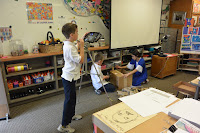This year the fourth grade teachers and the Design Team worked together to come up with a social studies project that would allow students to do more than simply memorize and recite the information they've learned about our home state of California.
We wanted them to apply their knowledge and skills in an authentic and engaging way. In other words, we wanted them to actually
do something with what they've learned! The project below, which ultimately turned out to be an interactive large-scale map of California, provides strong evidence of what our students were able to do with the information they learned and the skills they acquired across many disciplines. Skills like reading, writing, and research; content knowledge from social studies, science, technology, art, and design lab; and practice using essential habits of mind such as collaboration, communication, and creative problem solving...this project had it all!
This was essentially a year-long project - in the way that many year-long projects in schools go, it happened in fits and starts along side and in between other critical components of learning throughout the academic year. We would tackle a portion of the project as content learning occurred, and then put it aside for other work, returning to it when the content called for more work on the map. The map was tied into various parts of social studies curriculum. So, as an example, when students were studying missions, they would plug in missions on their map. This was done by determining how best to represent the missions as a "genre" on the map, and then ensuring missions were properly placed, identified, and labeled.
In essence, these maps measured approximately 6 feet tall and 3 feet wide, and they included:
Geographical features - 3d relief features and LED lights for san andreas fault
Missions - carpentry with qr codes with facts
Cities - dowel and flag - accuracy in location latitude/longitude
Points of interest - qr codes
Landmarks - highest, lowest point
Geographic regions - color and paint, textured, sand for deserts
Rocks/minerals - located them and used actual samples with qr codes with information
Explorer routes - denoted with flags and qr codes and marked the route with drawn on lines
State animals, state birds, and other student interest elements (surf spots)
Weaving in art - this was NOT on the map, but we integrated this as a tangental project that tied in gold rush studies with articulated art objectives for fourth grade, and it tied together learning components that we could not capture with the map project itself.
If a student team polished off a part of the map early, teachers prompted them to continue enhancing their maps with personal interest items. As always, at the close of the project, students were prompted to spend solid time reflecting on the product and thinking about the process they just went through. Kids reflect that they didn't have to like everyone but they did need to work well with them. They also shared that they under-estimated their groups. Students were harder on themselves than we would have been, which is ultimately great as it leads them to be critical of their work in the best of ways.
Reflection:
We would've loved to have had a bit more time - it would have made the maps really and truly incredible. As a teaching team, this was our first iteration on this project. While we liked the end result, we have reflected on how to do it differently next time and have several ideas on how to better incorporate the steps and create a more robust final product. Something we would love to do is create an outside audience for them to present their final products to in some way. If we find a good outside audience we could really focus the work for that and provide motivation to the kids as well. Could also be interesting to look at a partner school to work with on a project like this.
Below are several photos of the process:
 |
| Identifying the elements that need to be captured on the map |
 |
| Starting the process of creating the map - it was going to be BIG |
 |
| Student groups begin putting in geographical features |
 |
| We stressed accuracy as being absolutely vital to a successful product |
 |
| Students begin marking explorer routes and other items on their maps |
 |
| The map for this group is about 2/3s finished at this point |
 |
| Research - always more research before putting anything permanent on their maps! |
 |
| Students collaborate to ensure accuracy on placement of items |
 |
| Landforms begin taking shape |
 |
| Another group's landforms |
 |
| And again, back to researching to ensure their maps are perfect |
 |
| Laying down explorer routes and major cities |
 |
| Using plaster to represent landforms 3-D style |
 |
| A nearly finished product - hours of work, lots of pride! |













































